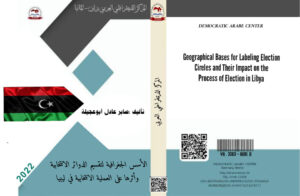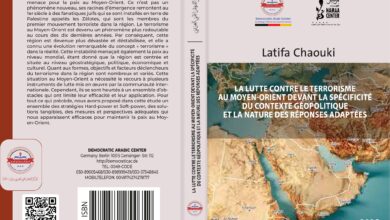الأسس الجغرافية لتقسيم الدوائر الانتخابية وأثرها على العملية الانتخابية في ليبيا
Geographical Bases for Labeling Election Cireles and Their Impact on the Process of Election in Libya

تأليف : عادل الصابر بوعجيلة
نسخة “pdf”-
الأسس الجغرافية لتقسيم الدوائر الانتخابية وأثرها على العملية الانتخابية في ليبيا
الطبعة الأولى “2022″ –من كتاب: – الأسس الجغرافية لتقسيم الدوائر الانتخابية وأثرها على العملية الانتخابية في ليبيا (دراسة تطبيقية على انتخابات المؤتمر الوطني لعام 2012م)
جميع حقوق الطبع محفوظة #المركز_الديمقراطي_العربي ولا يسمح بإعادة إصدار هذا الكتاب أو اي جزء منه أو تخزينه في نطاق إستعادة المعلومات أو نقله بأي شكل من الأشكال، دون إذن مسبق خطي من الناشر .
تقديم:
استهدف هذه الكتاب تبيان أهمية أثر تقسيم الدوائر الانتخابية بالمفهوم الذي بيناه، عن طريق تحليل القانون رقم (4) لسنة 2012م، لتسهيل إجراء العملية الانتخابية في كافة إنحاء البلاد، إنطلاقاً من اكتساب حق الاقتراع والتسجيل لسلامة تشكيل المؤتمر الوطني العام، الذي قسمة فيه البلاد الدوائر إلى دوائر إنتخابية؛ أو ما يعرف بالمرحلة التمهيدية لعملية الانتخاب، بوصفها الإجراءات والقرارات والضمانات التي تتخذ بهدف، تمكين كل من تتوافر فيه شروط الانتخاب من ممارسة هذا الحق وفق التشريعات المعمول بها في الدولة الليبية – والذي أنيط للمفوضية العليا للانتخابات عملية التحضير وإدارة ومراقبة انتخابات المؤتمر الوطني العام، فضلاً عن اعتماد وإعلان النتائج النهائية – وقد أوجب الإعلان الدستوري المؤقت لسنة 2011م، أن يكون الانتخاب سرياً ومباشراً وعاماً، وترك للقانون تنظيم كيفية اشتراك هيئة الناخبين في عملية الانتخاب، ولم ينص الإعلان الدستوري المؤقت على الأخذ بمبدأ الانتخاب الفردي أو الانتخاب بالقائمة، إلا أن قانون الانتخاب قد أخذ بهما معاً.
وذلك على قاعدة مناطق اقتراع يجري فيها الانتخابات، من تحديد مواقع اللجان الانتخابية في داخل الدوائر والتنظيم المكاني، لما له من أهمية تؤثر علي نتائج الانتخابات، حسب ما تطرحه الدراسات والتقارير التي ينشرها برنامج الأمم المتحدة الإنمائي (UNDP)، والعهد الدولي الخاص بالحقوق المدنية والسياسية، وإعلان الاتحاد البرلماني الدولي، والإعلان العالمي لحقوق الإنسان، وتحديد المعلومات التي واجهت تنفيذها لتقسيم الدوائر الانتخابية، والتي عرفها النظام السياسي الليبي عبر تجربة الإعلان الدستوري المؤقت بتحولاته المختلفة أهمها المرور من الأحادية الحزبية إلى التعددية السياسية التي كان للنظام الانتخابي دور كبير في إرساء قواعدها.
وفي إطارها النظري، عرضت الدراسة الإسهامات المختلفة التي تناولت موضوعات تقسيم الدوائر الانتخابية من ناحية التعريف، وأبعاد تقسيم؛ أو ترسيم الدوائر الانتخابية واستعراض المواضيع الرئيسية المتعلقة بالدوائر الانتخابية : نظام الدوائر، توزيع الدوائر، معايير تخطيط الدوائر بحسب النموذج الذي طرحه برنامج الأمم المتحدة الإنمائي، والذي تم التركيز عليه، باعتباره أنه يتضمن الأسس الرئيسية في تقسيم الدوائر الانتخابية، وبناء على هذا النموذج فقد تم التعرف على أساس تقسيم الدوائر الانتخابية، والتباين المكاني والمساحي وتوزيع الناخبين على دوائرهم، بما يساهم في فهم العلاقة بين العملية السياسية والحيز الجغرافي، والتي تم متابعة تطورها من خلال النمو السكاني وتوزيعهم وكثافتهم وامتدادهم والعوامل المؤثر فيهم.
وصولاً إلى تبنى هذه الكتاب مقترحه لتقسيم الدوائر الانتخابية يقوم على تحديد مقاعد البرلمان تبعا لعملية تعتمد استراتيجية التخطيط لسجلات الناخبين وحق الترشح بضوابط قانون تقسيم الدوائر الانتخابية والعملية التنظيمية، باعتبارهما عنصرين جوهريين للقوى الاجتماعية، لتوحيد الكيان السياسي للدولة الليبية، على قاعدة تعداد السكان كأساس لإعادة ترسيم الدوائر الانتخابية لتحقيق المساواة نسبياً ما بين الدوائر الانتخابية باعتبارها مبدا أساسي من مبادئ الديمقراطية، أذا ما اردنا أن يتحلى الناخبون بأصوات ذات وزن متساوي في عملية انتخابات الممثلين كحق في اختيار من يحكمهم.
Adel al saber pojila
Abstract
This book aimed to contrast the importance of the impact of the division of electoral districts in the concept we explained, by analyzing Law No. (4) of 2012 AD, to facilitate the conduct of the electoral process in all parts of the country, based on the acquisition of the right to vote and to register in order to secure the formation of the General National Congress, in which the country divided districts into electoral districts or what is known as the preliminary stage of the election process, as the procedures, decisions and guarantees that are taken with the aim of enabling all those who meet the election conditions to exercise this right in accordance with the legislation in force in the Libyan state – which is entrusted to the High Electoral Commission with the process of preparing, managing and monitoring the elections of the General National Congress, as well as approving and announcing the final results – the provisional constitutional declaration of 2011 required that the election be secret, direct and public – and left to the law to regulate how the electorate participates in the election process, the interim constitutional declaration did not provide for the adoption of the principle of individual or list election, but the election law adopted both.
This is based on polling areas in which elections are held, from determining the locations of the electoral commissions within the constituencies and the spatial organization, because of its importance that affects the results of the elections, according to the studies and reports published by the United Nations Development Program (UNDP) and the International Covenant on Civil and Political Rights the Inter-Parliamentary Union Declaration, the Universal Declaration of Human Rights, determining the information that was faced in implementing the division of electoral districts, which the Libyan political system knew through the experience of the temporary constitutional declaration with its various transformations, the most important of which is the passage from partisan unilateralism to political pluralism, in which the electoral system played a major role in establishing its bases.
In its theoretical framework, the study presented the various contributions that dealt with the issues of division of electoral districts in terms of definition, and the dimensions of division; or delineate electoral districts and review the main topics related to electoral districts: constituency system, district distribution, district planning criteria according to the model proposed by the United Nations Development Program, which was emphasized, as it includes the main foundations in the division of electoral districts, based on this model, the basis for the division of electoral districts, spatial and spatial variances and the distribution of voters to their districts were identified, which contributes to understanding the relationship between the political process and the geographical space, the development of which was followed up through population growth, distribution, density, extension and the factors affecting them.
In order for this book to adopt its proposal for the division of electoral districts based on determining parliament seats according to a process that adopts the planning strategy for voter registers and the right to run with the controls of the electoral division law and the organizational process, as they are two essential elements of social forces, to unify the political entity of the Libyan state, on the basis of the population census as a basis for re-demarcation Electoral districts To achieve relative equality between electoral districts as a basic principle of democracy, if we want voters to have votes of equal weight in the election process of representatives as a right to choose who governs them.
- الناشر: المركز الديمقراطي العربي للدراسات الإستراتيجية والسياسية والاقتصادية





